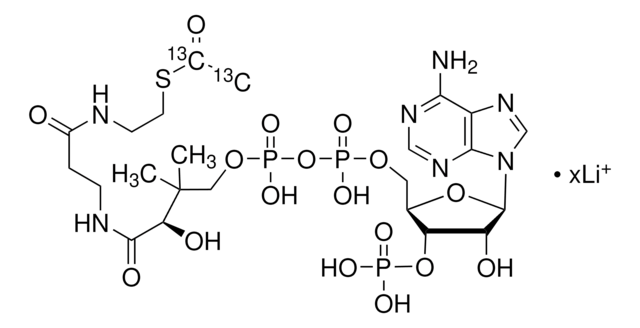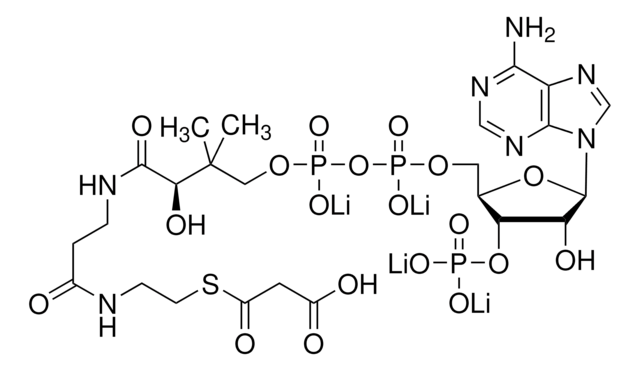Kluczowe dokumenty
A2181
Acetyl coenzyme A lithium salt
≥93% (HPLC)
Synonim(y):
Acetyl-CoA, Acetyl-S-CoA Li3
About This Item
Polecane produkty
Poziom jakości
Próba
≥93% (HPLC)
Formularz
powder
rozpuszczalność
H2O: soluble 100 mg/mL, clear, colorless
temp. przechowywania
−20°C
ciąg SMILES
[Li+].[Li+].[Li+].CC(=O)SCCNC(=O)CCNC(=O)[C@H](O)C(C)(C)COP([O-])(=O)OP([O-])(=O)OC[C@H]1O[C@H]([C@H](O)[C@@H]1OP(O)([O-])=O)n2cnc3c(N)ncnc23
InChI
1S/C23H38N7O17P3S.3Li/c1-12(31)51-7-6-25-14(32)4-5-26-21(35)18(34)23(2,3)9-44-50(41,42)47-49(39,40)43-8-13-17(46-48(36,37)38)16(33)22(45-13)30-11-29-15-19(24)27-10-28-20(15)30;;;/h10-11,13,16-18,22,33-34H,4-9H2,1-3H3,(H,25,32)(H,26,35)(H,39,40)(H,41,42)(H2,24,27,28)(H2,36,37,38);;;/q;3*+1/p-3/t13-,16-,17-,18+,22-;;;/m1.../s1
Klucz InChI
FTRFBNATWBKIQU-JHJDYNLLSA-K
informacje o genach
human ... CHAT(1103) , HAT1(8520) , KAT2A(2648) , KAT2B(8850) , KAT5(10524)
mouse ... HAT1(107435) , KAT2A(14534) , KAT2B(18519) , KAT5(81601)
rat ... HAT1(296501) , KAT2A(303539) , KAT2B(301164) , KAT5(192218)
Szukasz podobnych produktów? Odwiedź Przewodnik dotyczący porównywania produktów
Zastosowanie
Działania biochem./fizjol.
Właściwości fizyczne
Uwaga dotycząca przygotowania
Rekonstytucja
Inne uwagi
Hasło ostrzegawcze
Warning
Zwroty wskazujące rodzaj zagrożenia
Zwroty wskazujące środki ostrożności
Klasyfikacja zagrożeń
Eye Irrit. 2 - Skin Irrit. 2 - STOT SE 3
Organy docelowe
Respiratory system
Kod klasy składowania
11 - Combustible Solids
Klasa zagrożenia wodnego (WGK)
WGK 3
Temperatura zapłonu (°F)
Not applicable
Temperatura zapłonu (°C)
Not applicable
Środki ochrony indywidualnej
dust mask type N95 (US), Eyeshields, Gloves
Wybierz jedną z najnowszych wersji:
Masz już ten produkt?
Dokumenty związane z niedawno zakupionymi produktami zostały zamieszczone w Bibliotece dokumentów.
Klienci oglądali również te produkty
Nasz zespół naukowców ma doświadczenie we wszystkich obszarach badań, w tym w naukach przyrodniczych, materiałoznawstwie, syntezie chemicznej, chromatografii, analityce i wielu innych dziedzinach.
Skontaktuj się z zespołem ds. pomocy technicznej















